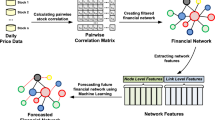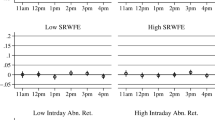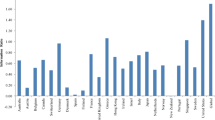Abstract
NYSE trading is a continuous auction process distinguished by order flow imbalances and non-coincident revision of the bid and the ask. To deal with the aggregation problem presented by non-coincident revision of the quotes, we propose a regime-level empirical model and use it to test the Brock and Kleidon queuing theory of a continuous auction. Using transactions data for IBM for calendar year 1988, Harris, McInish, and Chakravarity (1995) performed a Hausman-type specification test that confirmed the exogeneity of order flow volumes at the bid and the ask. Extending their work, this paper estimates two simultaneous autoregressive ask and bid equations for 50 randomly selected stocks and contrasts thinly traded and volatile stocks. The results support Brock and Kleidon's distinguishing implication—namely, exogenous increases in trading volume raise the ask and lower the bid. Although some queuing system characteristics prove endogenous in thinly traded stocks and in especially volatile stocks, exogenous order flow volume continues to increase spreads across the 50 stock sample. The paper draws conclusions about the appropriate specification of endogeneity, cross-equation disturbances from the bid to the ask, and cross-equation queuing information flows.
Similar content being viewed by others
References
Admati, A.R. and P. Pfleiderer, “A Theory of Intraday Patterns: Volume and Price Variability.” Review of Financial Studies 1 3–40, (1988).
Admati, A.R. and P. Pfleiderer, “Divide and Conquer: ATheory of Intraday and Day-of-theWeek Mean Effects.” Review of Financial Studies, 21, 89–223, (1989).
Benveniste, L., A. Marcus and W. Wilhelm, “What's Special About the Specialist?” Journal of Financial Economics 32, 61–86, (1992).
Blume, M. and M. Goldstein “Quotes, Order Flow, and Price Discovery.” Journal of Finance 52, 221–244, (1997).
Brock, W.A., and A. Kleidon, “Periodic Market Closure and Trading Volume: A Model of Intraday Bids and Asks.” Journal of Economic Dynamics and Control 16, 451–489, (1992).
Bronfman, C., From Trades to Orders on the NYSE: Pitfalls in Inferences Using Transactions Data, Working Paper. University of Arizona, 1991.
Brown, W.A., W.V. Harlow, and S.M. Tinic, “Risk Aversion, Uncertain Information and Market Efficiency.” Journal of Financial Economics 22, 355–85, (1988).
Chung, K.H., R. Van Ness, and B. Van Ness, “Limit Orders and the Bid-Ask Spread.” Journal of Financial Economics forthcoming, (1999).
Easley, D. and M. O'Hara, “Price, Trade Size, and Information in Securities Markets.” Journal of Financial Economics 19, 69–90, (1987).
Easley, D. and M. O'Hara, “Time and the Process of Security Price Adjustment.” Journal of Finance 47, 577–605, (1992).
Foster, F.D. and S. Viswanathan, “Variations in Trading Volume, Return Volatility, and Trading Costs: evidence on recent price formation.” Journal of Finance 48, 187–211, (1993).
French, K.R., “Stock Returns and the Weekend Effect.” Journal of Financial Economics 8, 55–70, (1980).
Garman, M.B., “Market Microstructure.” Journal of Financial Economics 3, 257–275, (1976).
Gibbons, M.R. and P.J. Hess, “Day of the Week Effects and Asset Returns.” Journal of Business 54, 579–596, (1981).
Glosten, L.R. and P.R. Milgrom, “Bid, Ask and Transaction Prices in a Specialist Market with Heterogeneously Informed Traders.” Journal of Financial Economics 14, 71–100, (1985).
Glosten, L.R., “Insider Trading, Liquidity, and the Role of the Monopolist Specialist.” Journal of Business 62, 211–236, (1989).
Greene, L.H., Econometric analysis, New York: Macmillan, 1990.
Gould, J.P., “Inventories and Stochastic Demand: Equilibrium Models of the Firm and Industry.” Journal of Business 51, 1–42, (1978).
Gould, J.P. and R. Verrechia, “The Specialist as an Economic Agent.” Journal of Business, 66–68, (1985).
Harris, F., “Competing Theories of Firm Decision Making Under Risk.” Southern Economic Journal, 54(2) 271–285, (1987).
Harris, F., T. McInish, and R. Chakravarty, “Bids and Asks in Disequilibrium Market Microstructure.” Journal of Banking and Finance, 19, 2, 323–345, (1995).
Harris, F., T. McInish, G. Shoesmith, and Bob Wood, “Cointegration, Error Correction, and Price Discovery on Three Informationally Linked Stock Exchanges.” Journal of Financial and Quantitative Analysis (1992).
Harris, F. and J. Pinder, “A Revenue Management Approach to Demand Management and Order Booking.” Journal of Operations Management, forthcoming (1995).
Harris, L., “ATransaction Data Survey of Weekly and Intraday Patterns in Stock Returns.” Journal of Financial Economics 16, 99–117, (1986).
Harris, L., “A Day-End Transaction Price Anomaly.” Journal of Financial and Quantitative Analysis, 24, 29–45, (1989).
Harris, L. and V. Panchapagesan, The information content of the limit order book: evidence from NYSE specialist auctions, Working paper, Los Angeles: University of Southern California, 1999.
Hasbrouck, J., “Trades, Quotes, Inventories and Information.” Journal of Financial Economics 22, 229–252, (1988).
Hasbrouck, J., “Measuring the Information Content of Stock Trades.” Journal of Finance 46, 179–207, (1991).
Hasbrouck, J. and D. Sosebee, Orders, Trades, Reports and Quotes at the New York Stock Exchange, New York Stock Exchange, 1992.
Hausman, J.A., “Specification Tests in Econometrics.” Econometrica, 46, 1251–1271, (1978).
Ho, T. and H.R. Stoll, “Optimal Dealer Pricing Under Transactions and Return Uncertainty.” Journal of Financial Economics 9, 47–73, (1981).
Jain, P.J. and G. Joh, “The Dependence Between Hourly Prices and Trading Volume.” Journal of Financial and Quantitative Analysis 23, 269283 (1988).
Kleidon, A., “Arbitrage, Non-Trading and Stale Prices.” Journal of Business 65, 483–508, (1992).
Kleidon, A. and R. Whaley, “One Market? Stocks, Futures, and Options During October 1987.” Journal of Finance 47, 851–878, (1992).
Kmenta, J., Elements of Econometrics, New York: Macmillan, 1986.
Kyle, A.S., “Continuous Auctions and Insider Trading.” Econometrica 53, 1315–1335, (1985).
Lee, C., “Market Integration and Price Execution for NYSE-Listed Securities.” Journal of Finance 48, 1009–1038, (1993).
Lee, C. and M. Ready, “Inferring Trade Direction from Intraday Data.” Journal of Finance 46, 733–746, (1991).
Lee, C., B. Mucklow, and M. Ready, “Spreads, Depths, and the Impact of Earnings Information: An intraday analysis.” Review of Financial Studies 6, 345–374, (1993).
Madhavan, A., and S. Smidt, “A Bayesian model of Intraday Specialist Pricing.” Journal of Financial Economics 30, 99–134, (1990).
Madhavan, A. and S. Smidt, “An Analysis of Changes in Specialists Inventories and Quotations.” Journal of Finance 48, 1595–1628, (1993).
McInish, T.H. and R.A. Wood, “A Transactions Data Analysis of the Variability of Common Stock Returns During 1980-1984.” Journal of Banking and Finance 14, 99–112, (1990).
McInish, T.H., and R.A. Wood, “An Analysis of Intraday Patterns in Bid/Ask Spreads for NYSE Stocks.” Journal of Finance 753–764, (1992).
McInish, T.H., and R.A. Wood “Hidden Limit Orders on the New York Stock Exchange.” Journal of portfolio management, Journal of Portfolio Management 21, 19–26, (1995).
Merton, R.C., “Optimum Consumption and Portfolio Rules in a Continuous-Time Model.” Journal of Economic Theory 3, 373–413, (1971).
NYSE Fact Book. New York: New York Stock Exchange, 1991.
Pagano, M., “Trading Volume and Asset Liquidity.” Quarterly Journal of Economics 104, 255–274, (1989).
Parkinson, M., “The Extreme Value Method for Estimating the Variance of the Rate of Return.” Journal of Business 53, 61–66, (1980).
Spencer, D.E. and K.N. Berk, “A Limited Information Specification Test.” Econometrica 49, 1079–1085, (1981).
Subrahmanyam, A. “Risk Aversion, Market Liquidity, and Price Efficiency.” Review of Financial Studies 4, 417–441, (1991).
Wood, R.A., T.H. McInish, and J.K. Ord, “An Investigation of Intraday Data for NYSE Stocks.” Journal of Finance 40, 723–741, (1985).
Author information
Authors and Affiliations
Rights and permissions
About this article
Cite this article
Harris, F.H.d., McInish, T.H. A Regime-Level Empirical Model of the Specialist Quote Revision Process. Review of Quantitative Finance and Accounting 14, 399–417 (2000). https://doi.org/10.1023/A:1008375911021
Issue Date:
DOI: https://doi.org/10.1023/A:1008375911021




